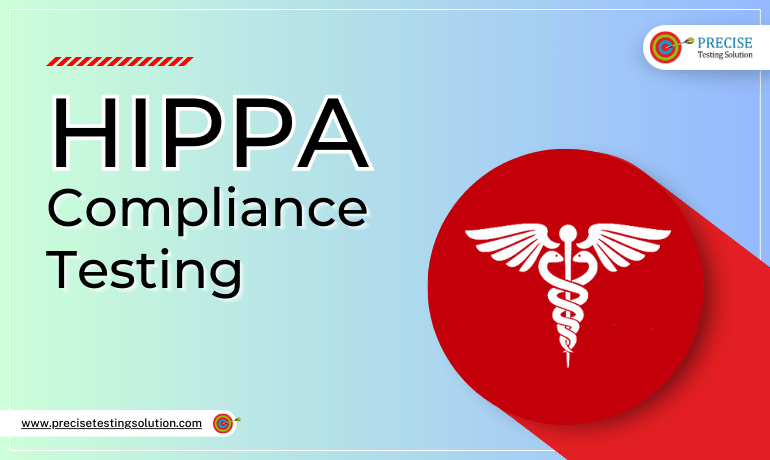What is HIPPA Compliance Testing?
In this blog post, we’ll discuss in-depth the importance of HIPPA Compliance Testing, the complete process of performing HIPPA Compliance Testing, the different strategic areas which should be in focus of test engineers in order to determine whether or not healthcare apps are HIPPA compliant by using the approach of software testing, and the many challenges which test engineers generally face while performing HIPPA Compliance Testing.
Importance of HIPPA Compliance Testing
1.Regardless of the field or sector it belongs to, data is the most private information that has to be secured. And among the numerous sectors that are suffering from huge data breach situations at an alarming rate are healthcare related firms.
2.Hence, HIIPA (Health Insurance Portability and Accountability Act of 1996) Compliance plays a crucial part in guaranteeing the stability and security of the developed healthcare software.
3.It is a federal legislation that outlines the requirements to be met in order to guarantee that private patient health information is not disclosed without the patient’s permission.
4.Any software or IT company creating a mobile app, web app, or IoT device must comply with HIPAA regulations. The process of testing healthcare applications to determine HIPPA compliance is known as HIPPA Compliance Testing.
5.Testing of health care applications is crucial for this reason because in the case of HIPAA compliance violations, it can result in severe fines and data theft of patient’s sensitive information.

Process of HIPPA Compliance Testing
The process contains the following steps that should be followed by test engineers when testing the healthcare software applications for HIPAA compliance:
Step 1) Determining the testing’s scope that will help the test engineers to decide which software elements will be evaluated for which HIPAA criteria will be addressed.
Step 2) Create test cases that cover all of the HIPAA regulations. These scenarios have to be created to confirm that the HIPAA requirements are followed by the healthcare software applications.
Step 3) Run the test cases, then record the test outcomes. Keep track of any changes from the expected outcomes and note any situations when the healthcare software applications that are under test don’t comply with HIPAA regulations.
Step 4) Analyse these test outcomes to determine any areas where the software is not in compliance with HIPAA regulations and give these areas a priority ranking according to the amount of risk they pose.
Step 5) Correct any non-compliant areas that were found during the testing that might involve changing the software, revising the policies and processes, or providing more employee training.
Step 6) Re-test the healthcare software apps to confirm that the default areas that have been fixed are now complying with HIPAA regulations or not.
Step 7) Record the entire testing procedure, including the test cases, situations, and outcomes. The usage of these documents can be utilized to demonstrate that HIPAA regulations have been met.
Step 8) Finally, to keep this entire testing process relevant with changes to HIPAA standards or regulations and the software itself, it should be reviewed and updated on a regular basis.
Therefore, following the above process, the test engineers can make sure that the software complies with HIPAA regulations and that they have proof of the compliance efforts in writing.
Strategic Areas of HIPPA Compliance Testing
While doing HIPAA compliance testing, the test engineers should pay close attention to the following strategic areas:
Testing Access Restrictions – The test engineers should test the software’s user authentication and authorization capabilities along with the required access restriction features, such as role-based access, two-factor authentication, and audit trails.
Testing Encrypted Data – Health information regarding patients should always be maintained in an encrypted format. Only authenticated users should be able to decrypt the shared data when they get access. To confirm that safe encryption keys are being employed, data should be tested. Risk analysis is also essential for minimizing the risks of data loss after encryption testing.
Testing Data Leakage – To maintain HIPAA compliance, testing for data leaks is also crucial. The test data in this case need to behave similarly to actual data. In order to assure high performance, testing huge data sets makes use of automated testing tools and data generating processes.
Testing Data Structures – There are various methods of organizing data in structured forms for each and every patient’s health record. To make sure that this data follows the requirements of HIPPA guidelines, the data structure must be tested using a variety of factors at different levels.
Testing Audit Trail – The ability to audit data is the primary need for HIPAA compliance. To ensure that any data changes are auditable, test the installation of the audit trail. The trail log should include every aspect of the most recent data modification. This will make it easier to recognize and correctly disclose data breaches.
Testing Load Balance & Failover – HIPAA compliance is essential since improperly handled or inaccurate data may endanger the patient’s life. To guarantee that healthcare activities continue uninterrupted even when backups are made, load balancing and failover testing must be done. In order to safeguard data, reduce data loss, and respond to data problems, these types of testing are necessary.
The Challenges of HIPPA Compliance Testing
The HIPAA test must be performed just to confirm that HIPAA requirements are satisfied throughout the testing process. However, the following challenges frequently arise for test engineers in ensuring HIPAA compliance:
- Issues like inability to produce HIPAA-compliant software due to a lack of expertise and resources.
- Issues of some development platforms that are without built-in HIPAA compliance mechanisms.
- Issues regarding strict standards for cybersecurity.
- Issues regarding flexibility and scalability for software’s data exchange.
Conclusion
Hence, from the above discussion, we can conclude to say that for building a software that incorporates HIPAA compliance, the HIPPA compliance testing is essential if you are in the healthcare industry and want your data to be in a secure environment for the benefit and trust of your patients.
For more information, visit our website at www.precisetestingsolution.com or call our office at 0120-368-3602. Also, you can send us an email at i[email protected].
We look forward to helping your business grow!
How to Identify Email Spoofing Attempts
What Is The History Of Spoofing Spoofing, in the
A Comprehensive Guide to Optimizing Your A/B Testing
What is A/B testing? Also known as split A/B


